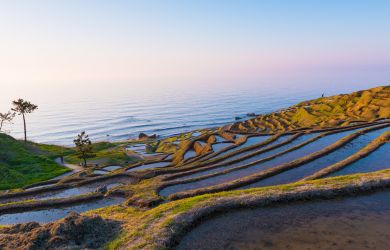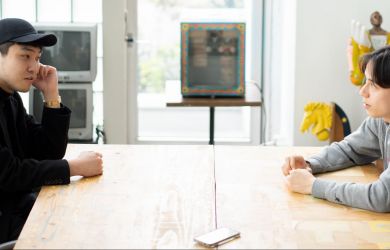
August 17, 2022
Koichiro Karu on Brazilian Jiujitsu in Japan
Bringing a modern phenomenon back to the homeland of martial arts
By Sean King
The popularity of Brazilian jiujitsu has been going through a noticeable rise recently. After receiving more of a spotlight from the world of mixed martial arts where Brazilian jiujitsu makes up a large majority of grounded combat in the sport, the once-Japanese fighting style has seen an increasing number of studios and gyms crop up worldwide. Though the Brazilian version has diverged quite a bit from the original Japanese style, it makes sense that it would eventually make a return in its new form to the capital of Japan.
Located in West Tokyo, Life Lab Koganei, owned by Koichiro Karu, brings the modern phenomenon back to the homeland of martial arts.
-scaled.jpg)
What is Brazilian Jiujitsu?
An obvious question when looking at a Brazilian jiujitsu dojo in Japan is: Why Brazilian? Jiujitsu is originally a Japanese martial art so surely, in the capital of Japan, the Japanese version would be more common. The answer lies within Karu’s own long martial arts background and the history of Brazilian jiujitsu itself.
Jiujitsu started in Japan in the era of samurai. The original founders wanted to create the strongest way of fighting that combined both throws and grappling. Over time, as new schools developed, the martial art split into two different focuses. One, which focuses on throws, became known as Judo. The other focused on the grappling side and is commonly referred to as jujitsu.
In the early 1900s, years after the two sides were honed and developed, judo master Mitsuyo Maeda emigrated from Japan to Brazil and ended up teaching the Gracie family the ancient Japanese technique. The Gracie’s of Brazil further developed Maeda’s art while leaning more into grappling.
They eventually started the school of Gracie Jiu-Jitsu. Years later, the family founded a staple of the martial arts world: The Ultimate Fighting Championship, with a promoter from the U.S.
In the first inaugural tournament, Royce Gracie used his family’s jiujitsu to take home first place. This win surprised the fighting community because Gracie was the smallest fighter there. From this incredible first win, the Brazilian form began to blow up around the world, but especially in the United States.
Full Circle
By this point, jiujitsu has come from Japan to Brazil to America. Why is it back in Japan now? At 20 years old, Koichiro Karu began studying at a University in LA. As is the case with many study-abroad students, he began to look for a hobby to enrich his life and social circles while away from home. He settled on martial arts, viewing them as healthy and useful for life. He ended up going with Gracie-style jiujitsu for similar reasons to why it took off in the United States in the first place. The control of grappling felt better to him than punching and kicking. And the leverage aspect was interesting in the sense that a smaller and weaker person could completely control a much larger person. While in the USA he continued to train until he got his blue belt in the sport. Eventually, his visa expired bringing him back to Japan.
Karu’s Life Lab is not the first of its kind in Japan, and he was able to continue his studies in Chiba until eventually joining the Kichijoji Paraestora Academy of Jiujitsu until he received his own blackbelt. He wanted to create his own place where people from all over can learn this historic sport and lifestyle. Thus began the Life Lab Brazilian Jiujitsu Paraestora Koganei dojo in 2019.
-scaled.jpg)
Why Jiujitsu?
Martial arts in general are a healthy way to stay active. Grappling especially uses muscles that most people don’t get a chance to use in daily life. Beyond that, it is a deceptively challenging cardio workout that helps build endurance which improves quality of life.
While jiujitsu, and the other UFC martial arts are generally seen as more for sport than self-defense, they can also be useful in real-life situations. There is a confidence that comes from learning the ability to defend oneself. Even though violent situations are taught to be avoided, it is nice to have the knowledge and experience to navigate one.
Jiujitsu is also a great way to socialize. It is not locked to just one type of person or demographic. You don’t have to be huge and strong, or light and agile. Even the smallest, weakest person can topple much larger foes through the use of leverage and controlling their center of gravity. And, much like the history of the martial art and Karu himself, the sport transcends borders and welcomes anyone from anywhere. Even at Life Lab, they have students from children to adults. From different backgrounds. The only real restriction is a soft upper age limit for beginners. Through martial arts you can meet different people from different backgrounds from a place of respect. As students learn together, bonds are built and connections are made.
-scaled.jpg)
“Martial arts really enriched my life. By doing it as a sport I could relieve stress, and by meeting people with respect and discipline I created a lot of memories. Through jiujitsu, I have enriched my life and improved as a person.” Explains Karu. “If you’re interested, it doesn’t have to be here, it doesn’t have to even be jiujitsu, but I definitely think you should try martial arts. It might open a world of fun.”
Karu’s goals are to maintain a good place for training so that people who come feel respected and can learn skills and discipline while having fun. Martial arts provide more than just a way to stay active for many people. They can be a lifelong passion that improves many aspects of life both on and off the mat.





